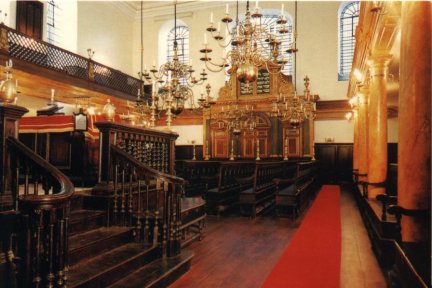| Orthodox Conversion to Judaism |
| The synagogue and its contents |
| The tabernacle in the wilderness and the Temple in Jerusalem were, before the Exile, the main centres of public worship, and symbolized the presence of G-d among the people. Priests offered the daily sacrifices on behalf of the community and it was only on special occasions that the individual took part in the Service. During their exile in Babylon the Jews came together for prayer and study, and on their return under Zerubabel, and later under Ezra, they continued this practice and the house of assembly became known as the Beit Knesset. The synagogue - a Greek word also meaning house of assembly - developed side by side with the Second Temple, and its Services were arranged on the pattern of the sacrificial system. In our Synagogues today are several features that remind us of the Tabernacle and Temple: 1) The Aron Hakodesh - the Holy Ark, represents the Holy of Holies, the innermost part of the Sanctuary and Temple, where even the High Priest could enter only on the Day of Atonement (Lev. xvi). The Ark in built on the eastern wall so that when we pray we face the direction of the Temple's site in Jerusalem. In Israel the Jews living east of Jerusalem build the Ark in the western wall for a similar reason. 2) The Ner Tamid - the continual lamp hanging before the Ark represents the lamp which burnt continually in the Sanctuary (Ex. xxvii, 20). 3) The Sefer Torah containing the Pentateuch is deposited in the Ark. It must be written in square Hebrew characters by a Sofer, an expert and pious scribe, using black ink on specially prepared parchment. Over the breastplate hangs the Yad or pointer - it is used for the Reading of the Torah. The two rollers round which the scroll is wrapped are given the name of Etz Chaim - the tree of life - by which name the Torah is called. The gold and silver ornaments adorning the Sefer Torah remind us of the ornaments of the High Priest and are called Klei Kodesh -sacred vessels. 4) The Bima or Almemar (the word is Arabic and means 'platform') was at one time used only for the Reading of the Law and Haftorah, and for Rabbinical discourses. In some Synagogues the Reader - known as the Chazzan or Sheliach Tzibur (representative of the Congregation) - leads the Congregation in prayer from a place lower than the Ark. This custom is based on the verse Out of the depths have I called to You, O Lord (Ps. cxxx, 1). 5) In obedience to the law contained in the Second Commandement, 'You shall not make unto yourself any graven image not any likeness...' No images or statues are permitted in the Synagogue. 6) Instrumental music was forbidden in Synagogues on Shabbat and Holy-days by the Rabbis; only in the Temple was music permitted on these days when sacrifices were offered. So the absence of music reminds us of the destruction of the Temple. 7) Women are seperated from men, just as in the Temple times. The intention is: maintaining prepriety and decorum during the Service. The association of the Synagogue with education began in very early days. The elementary school was for a long time next door to the Synagogue and so was the Beit Hamidrash, the school for higher learning. In time the Synagogue became the meeting-place for students and scholars. Many Synagogues today have a small room attached to them, known as a beit Hamidrash, where regular courses in Rabbinic studies are conducted, especialy on Shabbat. |
 |